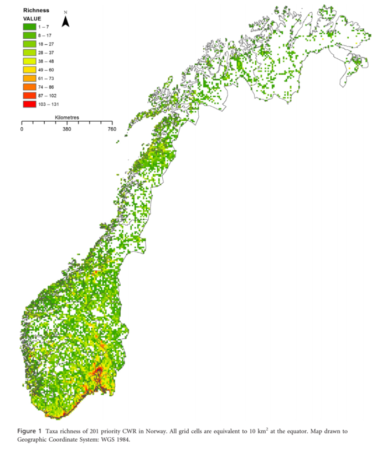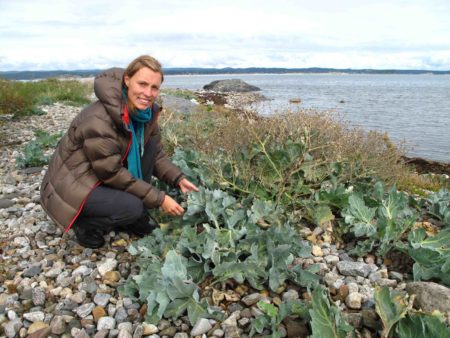Thanks to Jade Philips (see her on fieldwork below) and Åsmund Asdal, two of the authors, for contributing this post on their recent paper on the conservation of crop wild relatives in Norway.
![]() Norway may be an unlikely spot in which to look for agrobiodiversity, but seek and ye shall find. A recent paper discusses the development and implementation of an in situ and ex situ conservation strategy for priority crop wild relatives (CWR) in the country. 1 Some 204 taxa were prioritized, which included forage species, berries, vegetables and herbs. Distribution data collected from GBIF and species distribution modelling software including MaxEnt and the CAPFITOGEN tools were used to identify conservation priorities.
Norway may be an unlikely spot in which to look for agrobiodiversity, but seek and ye shall find. A recent paper discusses the development and implementation of an in situ and ex situ conservation strategy for priority crop wild relatives (CWR) in the country. 1 Some 204 taxa were prioritized, which included forage species, berries, vegetables and herbs. Distribution data collected from GBIF and species distribution modelling software including MaxEnt and the CAPFITOGEN tools were used to identify conservation priorities.
 A proposal was made for a network of in situ genetic reserves throughout Norway to help capture the genetic diversity of priority CWR and allow them to evolve along with environmental changes. Some 10% of priority species do not seem to be found in existing protected areas.
A proposal was made for a network of in situ genetic reserves throughout Norway to help capture the genetic diversity of priority CWR and allow them to evolve along with environmental changes. Some 10% of priority species do not seem to be found in existing protected areas.
Complementary ex situ priorities were also set out in the paper to ensure the full range of ecogeographic diversity across Norway, and hence genetic diversity, was captured within genebanks and therefore easily available for plant pre-breeders and breeders to utilise. Some 177 species have no ex situ collections at all. The priority CWR identified and the methodology used within Norway are applicable both in other countries and internationally. We hope that now the scientific basis for the conservation of these vital resources within Norway has been identified, integration of these recommendations into current conservation plans will begin. This will take us one step closer to the systematic global protection and use of our wild agrobiodiversity, a need which is growing increasingly urgent each day.

- Phillips, J., Asdal, A., Magos Brehm, J., Rasmussen, M., & Maxted, N. (2016). In situ and ex situ diversity analysis of priority crop wild relatives in Norway. Diversity and Distributions DOI: 10.1111/ddi.12470